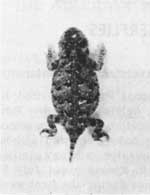A New Horned Toad Record for Crater Lake National Park
Although horned-toads are quite common in suitable habitats at lower elevations around Crater Lake National Park and at isolated localities in the Cascade Mountains (Gordon, 1939:68), they are obviously rare within the Park. Prior to this season there have been only two records for the Park (Farner and Kezer, M.S. 1951).
 Pigmy Horned Toad. Photograph of a preserved specimen. |
Campbell (1934:2) states that he saw a specimen “which had been caught by the CCC boys of the Wineglass Camp in the woods several miles down the Motorway which leaves Wineglass and goes toward the North boundary.” This locality is in good horned-toad habitat. Unfortunately this specimen was not preserved. Joseph S. Dixon obtained a specimen (MVZ 40761) collected by James Tucker “on August 15, 1944, at 6000 feet on pumice desert 5 miles north of Crater Lake about half way between Grouse Hill and Timber Crater.” We have searched this area for this lizard numerous times without success. One must not exclude the possibility that the specimen obtained by Dixon had escaped or was released by a visitor since the collecting locality is near a highway and since these little reptiles are frequently acquired and kept as pets.
On 26 June 1952 Park Naturalist Harry C. Parker and Assistant Park Naturalist Donald S. Farner collected a specimen (CLNP 523) along the Rim of Wheeler Creek Canyon at 5550 feet. Although this specimen was taken near the East Entrance Highway it can nevertheless be safely regarded as a legitimate record for the Park since the highway had not yet been opened to public travel for the season.
The horned-toads of Crater Lake National Park and vicinity are referred to Phrynosoma douglassii douglassii (Bell), the Pigmy Horned Toad (Farner and Kezer, M.S. 1951).
References
Campbell, Berry. 1934. Annotated list of the vertebrates of Crater Lake. Mimeographed, 22 pp.
Dixon, Joseph F. 1936-1945. Unpublished field notes recorded in Crater Lake National Park now in the files of the National Park Service, Region Four Office, San Francisco.
Farner, Donald S. and Kezer, James. 1951. Notes on the amphibians and reptiles of Crater Lake National Park. To appear in The American Midland Naturalist in 1953.
Gordon, Kenneth. 1939. The amphibia and reptilia of Oregon. Oregon State Monographs, Studies in Zoology, No. 3. 82 pp.
The 1952 Invasion of California Tortoise Shell Butterflies
At irregular intervals Crater Lake National Park is visited by huge numbers of Tortoise Shell Butterflies, Aglais californica Bdv. Previous invasions have been described by Scullen (1930), Constance (1931), and Lowrie (1951). Doubtless others have occurred without being recorded. The chronology of the 1952 invasion was very similar to that of 1951. The butterflies first began to appear about July 30 and seemed to reach their maximum abundance during the first week in August when prodigious numbers were to be observed in flight and resting on buildings. They were observed in abundance at the summits of Mt. Scott, the Watchman, and Dutton Cliff.
Doubtless these butterflies constitute an abundant source of food for several species of animals. During the last week of July and the first week of August there was a pronounced increase in the numbers of Clark’s Nutcrackers, Nucifraga columbiana(Wilson), along the Rim Highway. On several occasions I have noted them feeding on the California Tortoise Shells which had been killed by automobiles. The same observation has been made by Ranger-Naturalist R. M. Brown. On August 10, Ranger Naturalist C. Warren Fairbanks saw three ravens, Corvus corax Linnaeus, feeding on these butterflies on the highway near Llao Rock. He also found six in the stomach of a Rainbow Trout, Salmo gairdnerii Richardson, caught near Eagle Cove on August 17. Ranger-Naturalist Brown also observed a Golden-Mantled Ground Squirrel, Citteilus lateralis (Say), taking one on August 7 near Hillman Peak. These ground squirrels were frequently observed to take butterflies which dropped from the radiators of automobiles at the checking stations. The use of butterflies as food by the Golden-Mantled Ground Squirrel, however, is apparently not unusual (Gordon 1943:27).
References
Constance, L. 1931. A butterfly pilgrimage. Nature Notes from Crater Lake, 4(2):3-4.
Gordon, Kenneth. 1943. The natural history and behavior of the Western Chipmunk and the Mantled Ground Squirrel. Oregon State Monographs, Studies in Zoology, No. 5. 104 pp.
Lowrie, Donald C. 1951. Butterflies of Crater Lake National Park. Crater Lake Nature Notes, 17:10-11.
Scullen, H. A. 1930. The California Tortoise Shell Butterfly. Nature Notes from Crater Lake, 3(3):2.

